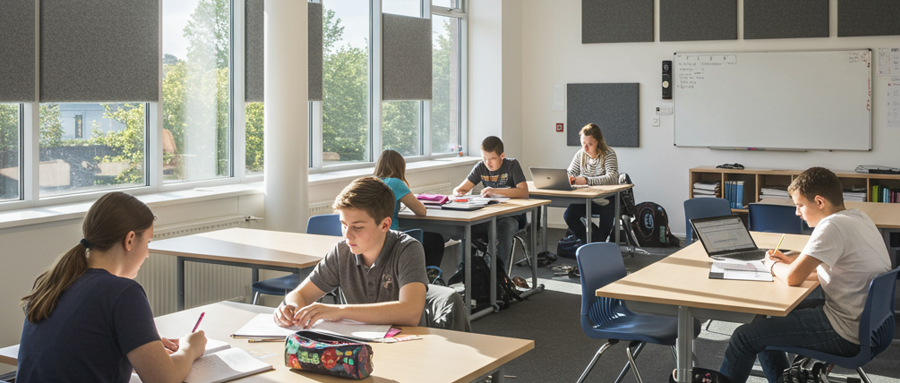Sound Decisions: Why Classroom Acoustics Matter for Learning (And How to Improve Them)

The modern classroom is a dynamic environment, buzzing with activity, collaboration, and the vibrant energy of learning. But what happens when that buzz becomes a distracting roar? Poor classroom acoustics are an often-overlooked barrier to student success, impacting everything from concentration and comprehension to student well-being and even teacher vocal health.
At Mitybilt, we understand that creating optimal learning environments goes beyond just durable desks and comfortable chairs. It's about crafting spaces where students can thrive. That's why we believe that addressing classroom acoustics is a sound decision for any educational institution.
The Undeniable Impact of Noise on Learning
Think about it: a student trying to decipher a complex math problem while battling echoes, reverberation from enthusiastic group work, or intrusive hallway noise. Research consistently shows that excessive noise and poor acoustics in classrooms can lead to:
- Decreased Speech Intelligibility: When students can't clearly hear the teacher or their peers, crucial information is lost. This is especially critical for younger learners developing language skills, students with hearing impairments, and those learning in a second language.
- Reduced Concentration and Focus: Constant background noise forces students to expend more cognitive energy just to listen, leaving less available for actual learning and information processing. This can manifest as shorter attention spans and difficulty staying on task.
- Increased Stress and Fatigue: A persistently noisy environment can be physiologically stressful for both students and educators, leading to fatigue, irritability, and a less positive classroom atmosphere.
- Impact on Reading and Comprehension: The ability to decode sounds is fundamental to reading. Poor acoustics can hinder this process and negatively affect overall comprehension skills.
- Teacher Vocal Strain: Educators in noisy classrooms often have to raise their voices, leading to vocal fatigue and potential long-term voice problems.
Who is Most Affected?
While all students benefit from good acoustics, some are particularly vulnerable to the negative effects of noisy classrooms:
- Younger Children: Their auditory systems and language processing skills are still developing, making them more susceptible to interference from background noise.
- Students with Hearing Loss: Even mild hearing loss can be significantly exacerbated by poor room acoustics.
- Students with Auditory Processing Disorders or Learning Disabilities: These students may find it especially challenging to filter out background noise and focus on relevant auditory information.
- English Language Learners: Clear acoustic environments are vital for distinguishing and understanding new sounds and speech patterns.
Creating Quieter, More Effective Learning Spaces
The good news is that there are practical solutions to improve classroom acoustics. While major structural changes can be costly, thoughtful design and furnishing choices can make a significant difference:
-
Strategic Use of Sound-Absorbing Materials: Incorporating materials that absorb sound, rather than reflect it, is key. This can include:
- Acoustic Wall Panels and Dividers: Products like Mitybilt’s own acoustic space dividers (such as our "Earth" and "Trees" designs or the "Acoustic Sacred Seven" panels) can effectively break up sound waves and reduce reverberation, creating quieter zones for focused learning or small group activities.
- Ceiling Treatments: Acoustic ceiling tiles are a common and effective solution.
- Floor Coverings: Carpets and rugs absorb sound much better than hard surfaces like tile or concrete.
- Soft Furnishings: Upholstered seating, cushions, and even fabric wall hangings can contribute to sound absorption.
-
Thoughtful Classroom Layout and Furniture Arrangement:
- Zoning: Arranging furniture to create distinct zones for quiet individual work, collaborative group activities, and direct instruction can help manage noise levels.
- Furniture Placement: Avoid placing noisy activity centers near quiet study areas. Consider how sound reflects off large, hard surfaces like whiteboards or windows.
- Flexible Furniture: Mobile partitions and easily reconfigurable furniture allow educators to adapt the space and its acoustic properties to different learning activities.
-
Addressing External Noise Sources:
- Ensure windows and doors are well-sealed to minimize noise intrusion from hallways or outside.
- Consider the placement of noisy equipment within the classroom.
-
Integrating Acoustic Considerations into New Builds and Renovations: For new school constructions or major renovations, it's crucial to involve acoustic consultants early in the design process. This allows for the integration of acoustic best practices from the ground up.
Mitybilt: Your Partner in Creating Optimal Learning Environments
At Mitybilt, we are committed to providing high-quality, durable, and thoughtfully designed furniture that supports the evolving needs of modern education. We recognize the critical role that classroom acoustics play in fostering effective learning.
While our focus is on durable and functional furniture, we also offer solutions that can contribute to better acoustic environments, such as our versatile space dividers. We believe that by paying attention to details like sound management, alongside providing robust and ergonomic furniture, we can help schools create spaces where every student has the best possible opportunity to learn, grow, and succeed.
Investing in good classroom acoustics is an investment in your students' future. Let's work together to make every classroom a place where learning truly resonates.
